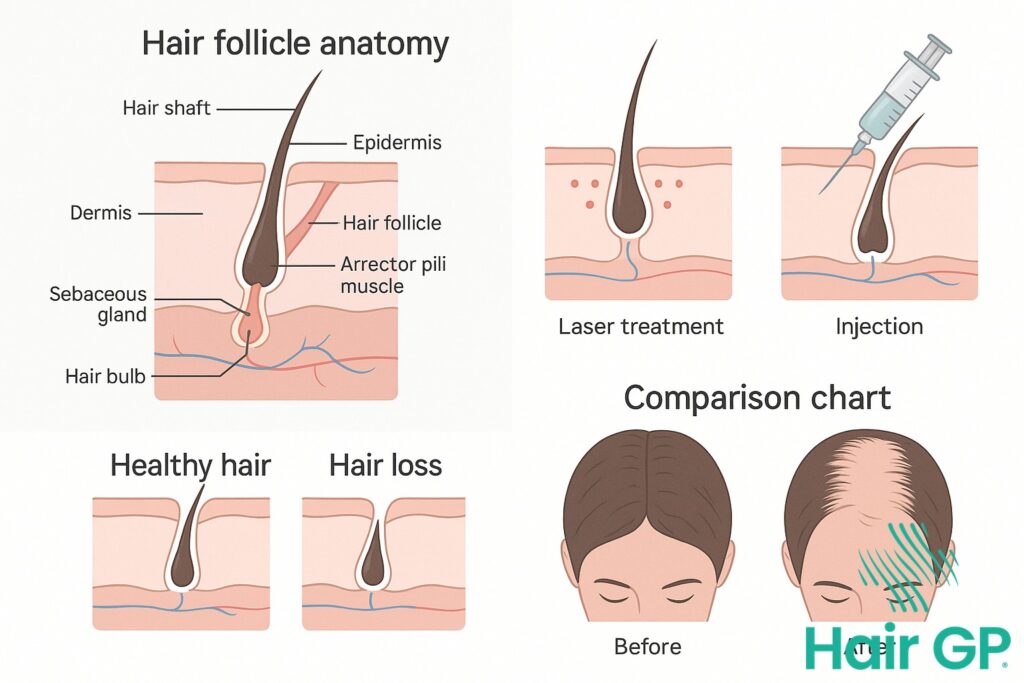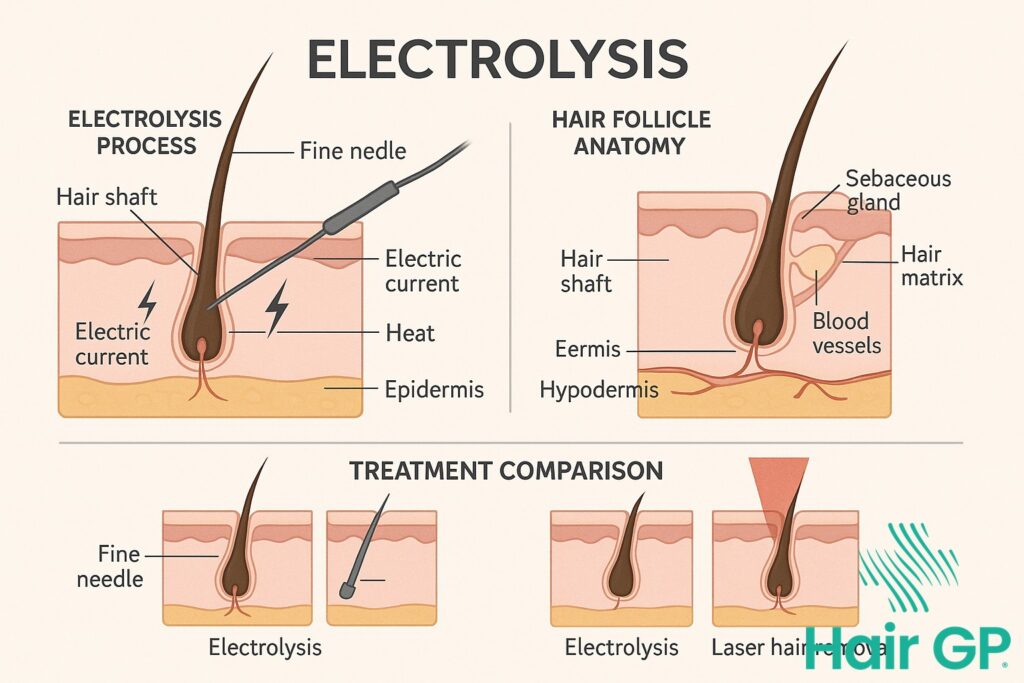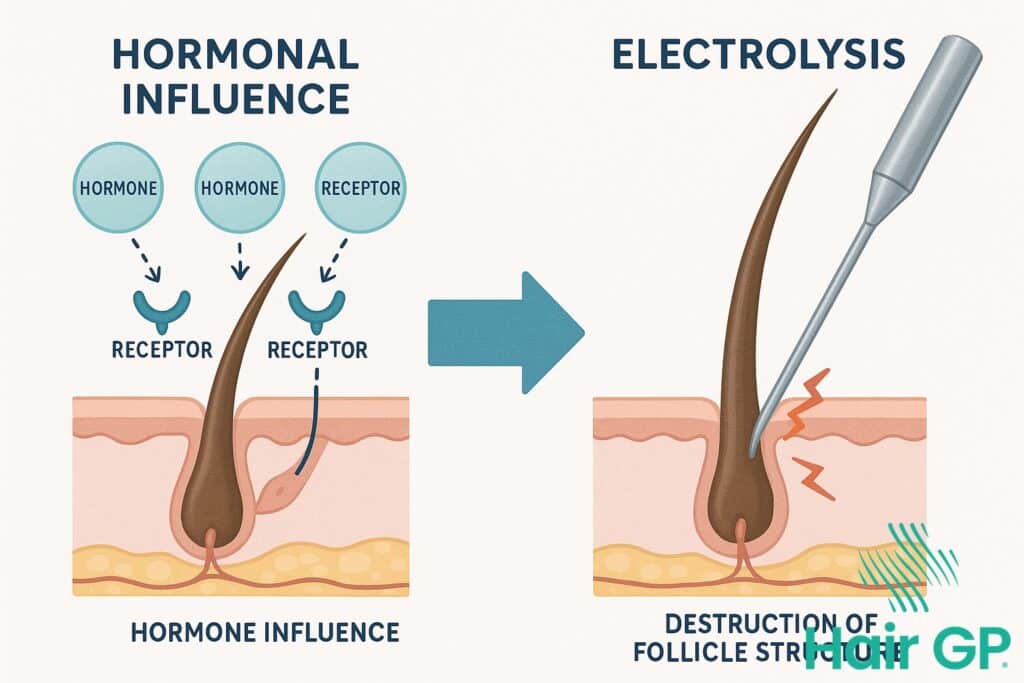Introduction
If you’re battling unwanted facial or body hair that keeps returning despite countless removal attempts, you’re not alone. From PCOS to hormonal imbalance, why electrolysis offers lasting relief for unwanted hair becomes clear when understanding the root cause. Polycystic ovary syndrome affects millions of women worldwide, with up to 80% experiencing hirsutism – excessive hair growth in unwanted areas.
Whilst temporary solutions like shaving, waxing, and even laser treatments may provide short-term relief, hormonal imbalances continue driving new hair growth patterns. Electrolysis stands apart as the only FDA-approved permanent hair removal method, uniquely capable of destroying hair follicles regardless of underlying hormonal conditions.
This comprehensive guide explores the science behind hormonal hair growth, examines why traditional methods fail, and reveals how electrolysis succeeds where others cannot. You’ll discover the biological mechanisms triggering unwanted hair growth, understand various hormonal conditions beyond PCOS, and learn how combining electrolysis with hormone management creates truly lasting results.
Key Takeaways – TL/DR
- Electrolysis is the only FDA-approved method for permanent hair removal, working on all skin tones and hair types
- Unlike laser treatments, electrolysis effectively treats hormonal hair by destroying individual hair follicles permanently
- Women with PCOS typically see 90-95% permanent reduction after completing full treatment sessions
- Combining electrolysis with hormone management provides the most comprehensive approach to excessive hair growth
Understanding Excess Hair Growth: The Hormonal Connection
Excessive hair growth isn’t simply a cosmetic concern – it’s a complex biological response to hormonal imbalances that transforms normal hair follicles into thick, coarse terminal hairs. Unlike typical hair growth patterns, hormonal hair develops when sensitive follicles respond to elevated androgens, creating persistent growth that traditional removal methods cannot permanently address.
How Male Hormones Trigger Female Hair Growth
Women naturally produce small amounts of testosterone and other male hormones, but when hormone levels rise above normal ranges, unwanted hair appears[1]. The enzyme 5-alpha reductase converts testosterone into dihydrotestosterone (DHT) within hair follicles, triggering excessive hair growth in hormone-sensitive areas[2]. Face, chest, and abdomen follicles show heightened androgen sensitivity compared to scalp follicles, explaining why hormonal fluctuations affect these regions differently.
Insulin resistance, commonly seen in PCOS symptoms, amplifies this process by increasing androgen production and reducing sex hormone-binding globulin[3]. This creates a cycle where elevated insulin drives more testosterone production, whilst each hair follicle’s unique hormone receptors determine growth intensity – explaining why some women experience mild changes whilst others develop significant hirsutism requiring comprehensive hormone testing.
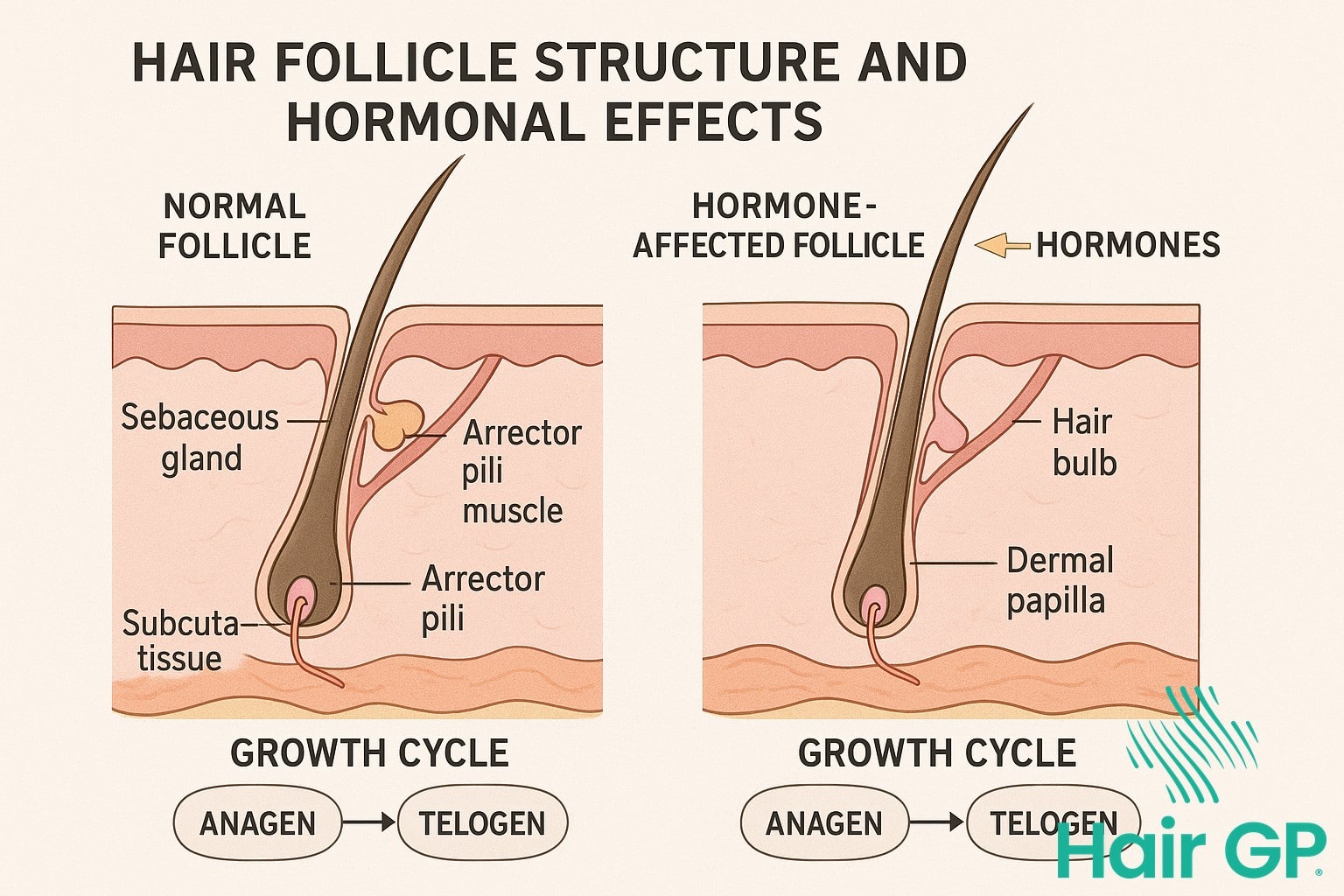
Polycystic Ovary Syndrome (PCOS) and Unwanted Hair
Polycystic ovary syndrome (PCOS) stands as the most common hormonal disorder amongst women of reproductive age, affecting up to 10% of this population and triggering excessive hair growth in 70-80% of cases [4]. The condition disrupts normal ovarian function, leading to irregular menstrual cycles and elevated androgen levels that drive unwanted hair growth in masculine patterns.
The PCOS-Insulin-Hair Growth Triangle
The relationship between insulin resistance and PCOS-related hirsutism creates a challenging cycle. Elevated insulin levels directly stimulate the ovaries to produce excess androgens, whilst simultaneously reducing sex hormone-binding globulin production [5]. This metabolic dysfunction means that up to 70% of women with polycystic ovary syndrome PCOS experience insulin resistance, regardless of body weight. However, weight gain further exacerbates the problem, as adipose tissue increases insulin resistance and androgen production. Women with irregular periods often notice worsening hirsutism alongside metabolic changes, making comprehensive hormone management essential for successful treatment outcomes.
Other Hormonal Conditions Causing Excessive Hair Growth
Beyond PCOS, several hormonal conditions trigger unwanted hair growth requiring medical consultation. Thyroid disorders, particularly hypothyroidism, disrupt normal hormones causing both hair loss and paradoxical hair growth in unwanted areas. Congenital adrenal hyperplasia affects the adrenal glands, occurring in 1 in 14,000 births[6], leading to excess androgen production and subsequent hirsutism.
Certain medications can induce hormonal changes mimicking hirsutism. Corticosteroids, phenytoin, and minoxidil commonly cause unwanted hair growth[7], whilst spironolactone, paradoxically used to treat hirsutism, may initially worsen symptoms before improvement. Hormone testing helps identify these underlying hormonal conditions, enabling targeted treatment alongside electrolysis for comprehensive management. Recognition of medication-induced causes proves crucial, as adjusting dosages or switching medications often resolves excessive hair growth when combined with permanent removal methods.
How Electrolysis Works: The Science of Permanent Hair Removal
Electrolysis works by inserting a fine needle into individual hair follicles and delivering electrical current that creates a chemical reaction, permanently destroying the follicle’s growth cells. Unlike laser treatments, this permanent hair removal method effectively targets all hair colours and skin types because it doesn’t rely on pigment absorption.
Three Types of Electrolysis Methods
Galvanic electrolysis uses direct electric current to trigger chemical destruction through sodium hydroxide formation within the follicle. Thermolysis employs high-frequency alternating current, generating heat that coagulates and destroys follicular tissue instantly. The blend method combines both approaches, using thermolysis to accelerate the chemical reaction from galvanic current, offering enhanced effectiveness. Each method permanently disables the follicle’s regenerative capacity, though practitioners select techniques based on hair characteristics and treatment areas. Understanding how electrolysis works helps patients appreciate why multiple sessions ensure complete, permanent results regardless of hormonal influences.
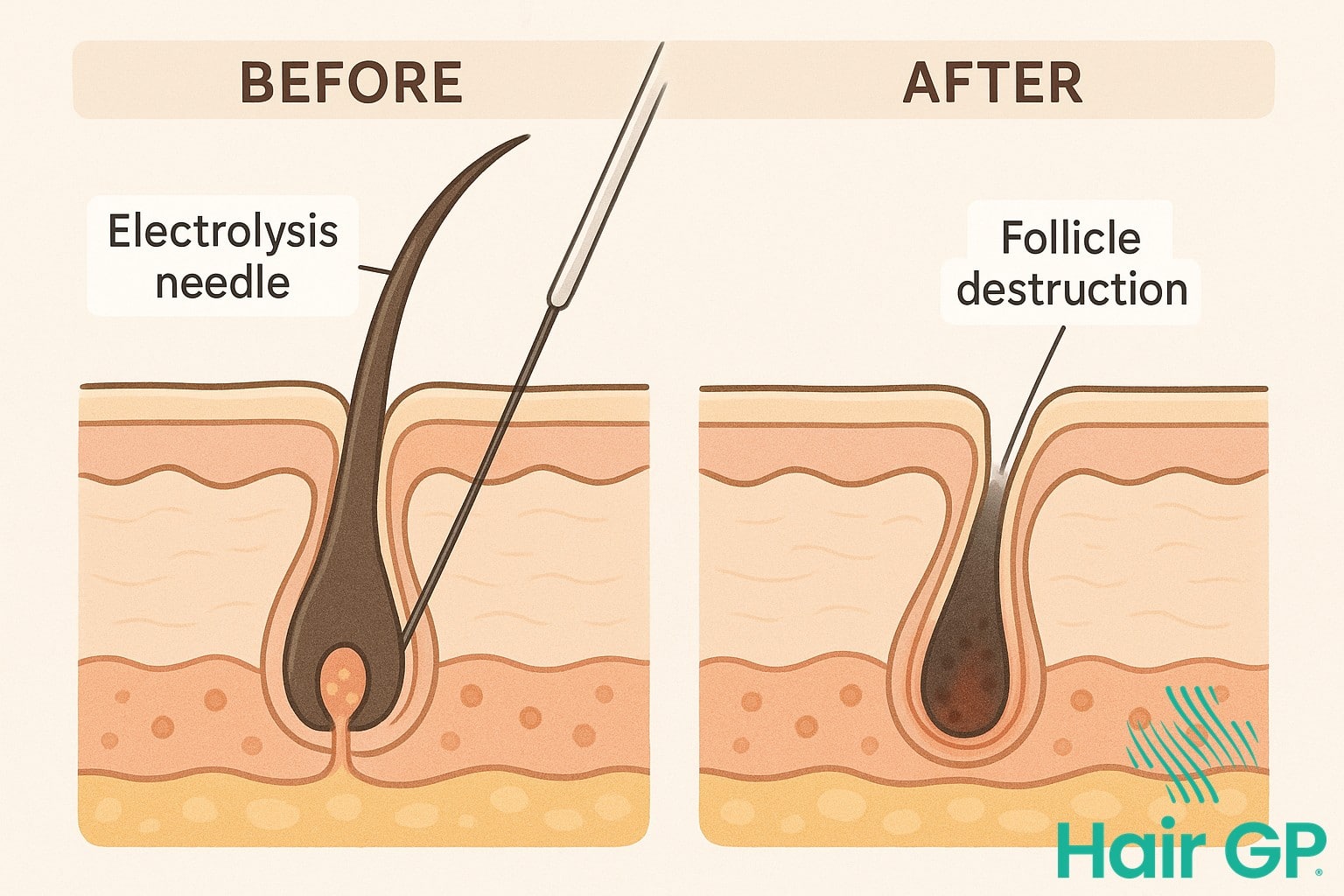
Electrolysis Hair Removal vs. Laser Hair Removal: Critical Differences
When comparing electrolysis hair removal and laser hair removal for hormonal conditions, fundamental differences in their mechanisms determine treatment success. While laser treatments target pigment in dark hair follicles, electrolysis destroys the growth centre directly, making it the only FDA-approved permanent solution for all hair types and skin tones[8].
Why Laser Fails on Hormonal Hair
Laser therapy requires strong pigment contrast between hair and skin to effectively target follicles, limiting effectiveness on lighter hair colours[9]. More critically for hormonal conditions, laser cannot prevent new hair growth from dormant follicles activated by ongoing hormonal stimulation. Studies show that hormonal hair treated with laser typically returns within 6-12 months as androgens continue stimulating new follicle development[10]. This temporary reduction forces patients into endless laser treatments, as the underlying hormonal drive continuously creates new growth cycles. Unlike electrolysis, which permanently destroys each treated follicle regardless of colour or hormonal status, laser merely damages existing pigmented hair without addressing the root hormonal cause.
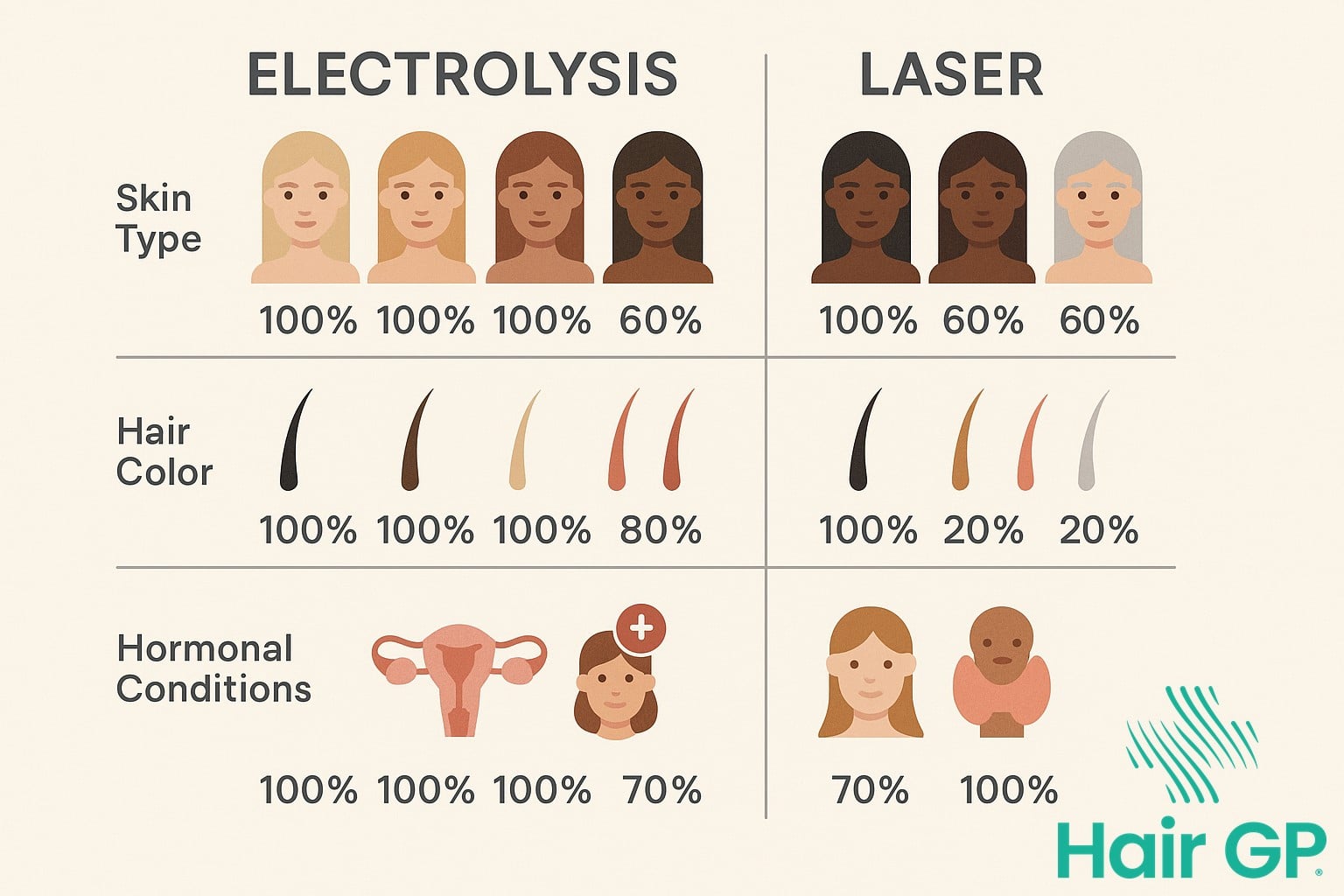
Addressing the Root Cause: Combining Electrolysis with Hormone Management
Achieving lasting results requires addressing both visible symptoms and underlying hormonal imbalances. While electrolysis permanently destroys existing hair follicles, managing the root cause prevents future hair growth from developing. Studies demonstrate that combining electrolysis with anti-androgen medications like spironolactone significantly improves long-term outcomes for hirsutism [11]. This integrated treatment plan tackles the problem from both directions – removing current unwanted hair whilst preventing new follicles from becoming terminal hairs.
Beyond medication, lifestyle modifications play a crucial role in hormonal balance. A nutrition-focused approach incorporating dietary changes can enhance treatment effectiveness. Regular exercise, maintaining healthy weight, and following an anti-inflammatory diet support hormone regulation naturally. Working with both a hormone specialist and certified electrologist ensures comprehensive care. This long term solution addresses not just cosmetic concerns but overall metabolic health, providing sustainable results that transcend temporary fixes.
The Electrolysis Treatment Journey: What to Expect
Beginning your electrolysis journey requires understanding the commitment involved for permanent hair removal. An experienced electrologist will develop a personalised treatment plan during your initial consultation, mapping out realistic timelines based on your specific needs and desired results.
Treatment Areas and Session Planning
The number of sessions depends primarily on the treatment area and hair type. Facial regions like the upper lip and chin typically require 15-30 sessions, whilst larger body areas such as the chest and lower abdomen need additional appointments. Hormonal hair often demands more extensive treatment over several months, as new follicles may activate during the process. Most clients schedule weekly or fortnightly sessions initially, gradually spacing appointments as hair growth diminishes. Your electrologist will adjust your treatment plan based on progress, ensuring optimal results whilst managing both time and budget expectations effectively.
Conclusion
Electrolysis stands as the only FDA approved method offering a permanent solution for unwanted hormonal hair growth. This lasting solution transforms lives by restoring self confidence through complete follicle destruction. Whilst treatment requires commitment, choosing an experienced, certified electrologist ensures optimal results and safety throughout your journey. Schedule your consultation today to discuss your specific needs and develop a personalised treatment plan that addresses your unique hormonal hair concerns effectively and permanently.
Frequently Asked Questions
Yes, electrolysis permanently destroys treated follicles. However, PCOS can stimulate new follicles to grow hair, which is why combining electrolysis with hormone management is ideal.
Most women with hormonal hair need 15-30 sessions over 12-18 months for facial areas, though this varies based on hair density and hormonal factors.
Yes, combining electrolysis with spironolactone is actually recommended as it addresses both existing hair and prevents new growth.
References
- Azziz R, Sanchez LA, Knochenhauer ES, et al. Androgen excess in women: experience with over 1000 consecutive patients. J Clin Endocrinol Metab. 2004;89(2):453-462.
- Randall VA. Androgens and hair growth. Dermatol Ther. 2008;21(5):314-328.
- Rosenfield RL, Ehrmann DA. The Pathogenesis of Polycystic Ovary Syndrome (PCOS): The Hypothesis of PCOS as Functional Ovarian Hyperandrogenism Revisited. Endocr Rev. 2016;37(5):467-520.
- Deswal R, Narwal V, Dang A, Pundir CS. The Prevalence of Polycystic Ovary Syndrome: A Brief Systematic Review. J Hum Reprod Sci. 2020;13(4):261-271.
- Rosenfield RL, Ehrmann DA. The Pathogenesis of Polycystic Ovary Syndrome (PCOS): The Hypothesis of PCOS as Functional Ovarian Hyperandrogenism Revisited. Endocr Rev. 2016;37(5):467-520.
- Speiser PW, Azziz R, Baskin LS, et al. Congenital adrenal hyperplasia due to steroid 21-hydroxylase deficiency: an Endocrine Society clinical practice guideline. J Clin Endocrinol Metab. 2010;95(9):4133-4160.
- Castelo-Soccio L. Diagnosis and management of hirsutism in adolescents. Pediatr Clin North Am. 2019;66(1):229-241.
- Gan SD, Graber EM. Laser hair removal: a review. Dermatol Surg. 2013;39(6):823-838.
- Haedersdal M, Haak CS. Hair removal. Curr Probl Dermatol. 2011;42:111-121.
- Ormiga P, Ishida CE, Boechat A, Ramos-E-Silva M. Comparison of the effect of diode laser versus intense pulsed light in axillary hair removal. Dermatol Surg. 2014;40(10):1061-1069.
- Barrionuevo P, Nabhan M, Altayar O, et al. Treatment Options for Hirsutism: A Systematic Review and Network Meta-Analysis. J Clin Endocrinol Metab. 2018;103(4):1258-1264.

